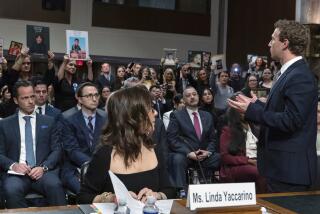Peoria to Tell How Well Television’s New On-Air Ratings System Plays
- Share via
NEW YORK — After months of controversy on Capitol Hill, the debate over the television industry’s on-air parental guidelines today is moving to the viewers for whom they were intended: 300 families from Peoria, Ill., the city that is synonymous with Middle American values and market research, will rate the ratings in a televised, “Oprah”-style congressional hearing.
The families--who agreed to watch TV closely last week to prepare for the hearing--will tell moderator Sander Vanocur and the members of a House subcommittee what they think of the 4-month-old ratings system and how it helps--or does not help--them to screen out potentially objectionable programming.
Clips from last week’s television fare, ranging from “Seinfeld” to the miniseries “The Last Don,” will be shown as case studies during the unusual “town hall” hearing. The forum will be televised live from 5 p.m. to 8 p.m. (PDT) from Bradley University on C-SPAN.
“We’ve heard from members of Congress and lobbyists in Washington on this issue--it’s time to hear from the American public,” said Rep. W.J. “Billy” Tauzin (R-La.), who as chairman of the House Commerce subcommittee on telecommunications, trade and consumer protection, organized the meeting.
Television executives maintain that the movie-style ratings, employing symbols such as TV-PG and TV-14 to indicate whether a program is suitable for specific age groups, are simple, familiar and easy to use. They are hoping the parents of Peoria will echo those sentiments and give them ammunition to fight off critics in Congress and children’s advocacy organizations who want the ratings to give viewers more information about how much violence, sex and foul language each program contains.
“After all the negative press on the ratings, I’d settle for grudging acceptance,” one network executive said, only half-jokingly, of the Peoria hearing.
Tauzin--who is considered more sympathetic to broadcasters than Sen. John McCain (R-Ariz.), chairman of the Senate Commerce Committee that has similar oversight authority regarding television--was critical of the Senate panel’s February hearing in which the industry took a beating from critics over the ratings code, which went into effect Jan. 1.
“TV ratings are a serious 1st Amendment issue--freedom of speech is on the table,” Tauzin said. “The industry has made a doggone good start [with its guidelines], and the purpose of this Peoria meeting is to facilitate a dialogue between the industry and the American public over what changes should be made in the system. Politicians shouldn’t be speaking first on this issue--the 1st Amendment was designed to protect the public from congressmen.”
Critics of the industry’s system, who cite numerous polls saying that parents would like more specific information on program content, are already saying that the Peoria forum won’t be a definitive test because the viewers in the survey have not been presented with an alternate system.
“This will be interesting theater and an interesting public discussion, but it’s not as definitive as a national survey of parents,” said Rep. Edward J. Markey (D-Mass.), the ranking Democrat on the subcommittee and a chief critic of the industry’s system.
As evidence of parents’ views, Markey cited a USA Today poll in which 81% of the 22,000 respondents said they don’t trust the TV industry to rate its own shows, and 65% said the ratings should include a combination of symbols for content and age-appropriateness.
The TV industry will have some advantages in the format of the Peoria hearing. No children’s or parents’ groups will testify, while the TV industry will have three representatives--including Jack Valenti, the chief architect of the rankings--to explain their system in a 15-minute presentation. But Markey intends to discuss the alternative of a content-based system, which would use symbols to designate programs with high contents of sex, foul language and violence.
And critics of the industry guidelines have said they believe that the Peoria parents themselves will find flaws in the present system, which labeled about two-thirds of shows in prime time “PG” during the first weeks of the guidelines--a rating that means the program is deemed suitable for all but the youngest children.
“I wish we had someone from the national PTA or some other dissenting group to present the other side,” Markey said. “But the industry’s system has flaws, and I believe that parents want more information--not less--about TV programming.”
The debate will not end in Peoria. The ratings are under review at the Federal Communications Commission, which will hold a public hearing on the matter next month. The regulatory agency could decide to reject the industry system and then form a panel to come up with an alternative. The agency lacks the power, however, to force the industry to use a substitute system.
More to Read
The complete guide to home viewing
Get Screen Gab for everything about the TV shows and streaming movies everyone’s talking about.
You may occasionally receive promotional content from the Los Angeles Times.





